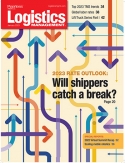Quick order to delivery turnaround times can create supply chain challenges, says PwC
It goes without saying that in these days of rapid e-commerce growth, consumers are getting more accustomed to getting what they want, or ordered, when they want it. This, in turn, creates challenges for retailers to get orders to customers, challenges that can be expensive but needed. That is a key takeaway from the 2017 Holiday Outlook recently issued by PwC.
in the News
POLA and POLB see solid December and 2022 volumes despite annual declines Barcoding, Inc., acquires AGV provider FRED Automation U.S. rail carload and intermodal volumes are mixed, for week ending January 14, reports AAR C&B Material Handling acquires new forklift dealership groups Single-Carrier vs. Multi-Carrier Shipping Stategies More NewsIt goes without saying that in these days of rapid e-commerce growth, consumers are getting more accustomed to getting what they want, or ordered, when they want it. This, in turn, creates challenges for retailers to get orders to customers, challenges that can be expensive but needed.
That is a key takeaway from the 2017 Holiday Outlook recently issued by PwC.
The supply chain- and logistics-related findings from PwC in its outlook included how:
- -almost 4 in 10 consumers (39%) prefer to have their good delivered in two days or less; and
- -50% of consumers say delivery between three and five days is acceptable
While these types of trends have become standard expectations for consumers, things are viewed somewhat differently by retailers’ supply chains in that things like same day delivery, return shipping and related fees all have the same thing in common, says PwC: they are expensive and can have a negative impact on the bottom line, more so during the holiday shopping season than other times of the year.
“The persistent growth in online shipping, compounded by expectations of expedited delivery, has mandated a corresponding reconfiguration of the entire distribution network,” PwC said. “In response, retailers have shifted their focus from behemoth distribution centers in the heartland to more nimble versions with smaller versions close to population centers. Today distribution centers dot the landscape of every metro market worldwide.”
What’s more, PwC observed that in large metropolitan areas, former manufacturing facilities in industrial parks are more often functioning as distribution centers for retailers, with proximity to highways making them highly desirable in an instant pick-up era with same-day delivery fast becoming more commonplace. And in exurban areas former malls that are close to major highways are also making way for distribution centers after zoning changes.
PwC Managing Director Tim Laseter toldLMin an interview that the increased onus, or emphasis, on quick turnaround times for orders becomes more heightened leading up to the holiday season rush. And of the central themes of that is how retailers are focusing heavily on restructuring their distribution networks.
“One of my reseller clients said to me that his company needs to stop building distribution centers at highway junctions in the middle of nowhere and start putting them outside or as close as we can to major population centers,” he said. “That is what we are seeing more of in terms of structural changes to the network. The focus is on major metropolitan networks. For example, we likely will not have same day delivery in a place like Charlottesville, Virginia for a really long time. But in major cities [and population centers] that is increasingly becoming an expectation.”
As for the holiday season Laseter said things are somewhat different, citing an old supply chain saying along the lines of ‘everybody likes speed but as a trade off what everybody wants more is predictability.’
“If delivery is promised in two days and it always arrives in two days, I can work with that most of the time,” he said. “The holiday season is pretty predictable in terms of when things are going to hit. 24-hour delivery is not a requirement as much as an assurance that the order will arrive in a timely manner. That is an important part of the holiday equation.”
PwC’s findings also touched upon free delivery, with the key takeaways being that 30% want same-day delivery; 22% want next-day delivery; and 20% indicated they want standard delivery.
This speaks, said Laseter, to consumers more than often preferring the lowest-cost option.
“But even though it may be called ‘free shipping,’ there is always a related cost,” he said. “Increasingly, as the B2C sector has 111 distribution centers that average close to 90 million square-feet [cumulatively] covering every major area of the U.S., even with a two-day promise, retailers are increasingly trying to get it done next-day just because of the volume and scale that they have and their ability to get things out. They are setting consumer expectations that ultimately is hard for others to cost-effectively match.”
As distribution network strategies, which are spurred on by things like e-commerce, automation, and last-mile logistics, among other things, Laseter said that retail supply chains need to focus less on predicting demand than shaping demand and expectations, specifically when trying to compete with the largest players, whose scale cannot be matched.
“挑战将继续是do you shape customer expectations…rather than just playing catch-up,” he said. “Nobody wins by just playing catch-up, as that can be a losing game to play.”

About the Author
 Jeff Berman, Group News EditorJeff Berman is Group News Editor for万博2.0app下载,Modern Materials Handling, andSupply Chain Management Review. Jeff works and lives in Cape Elizabeth, Maine, where he covers all aspects of the supply chain, logistics, freight transportation, and materials handling sectors on a daily basis.Contact Jeff Berman
Jeff Berman, Group News EditorJeff Berman is Group News Editor for万博2.0app下载,Modern Materials Handling, andSupply Chain Management Review. Jeff works and lives in Cape Elizabeth, Maine, where he covers all aspects of the supply chain, logistics, freight transportation, and materials handling sectors on a daily basis.Contact Jeff Berman

Subscribe to Logistics Management Magazine!
Subscribe today. It's FREE!Get timely insider information that you can use to better manage your entire logistics operation.
Start your FREE subscription today!
 Single-Carrier vs. Multi-Carrier Shipping Stategies
Download the white paper to learn about the benefits of multi-carrier shipping with EasyPost.
Download Today!
Single-Carrier vs. Multi-Carrier Shipping Stategies
Download the white paper to learn about the benefits of multi-carrier shipping with EasyPost.
Download Today!
 我们的货运年会万博ag客户端appustry analysts reveals some common themes, largely around the notion that rates are not likely to increase much—if at all—in some modes and will continue declining in others. Does this mean things are stabilizing?
我们的货运年会万博ag客户端appustry analysts reveals some common themes, largely around the notion that rates are not likely to increase much—if at all—in some modes and will continue declining in others. Does this mean things are stabilizing?LM Viewpoint on the 2023 Rate Outlook: Will shippers catch a break? Global Labor Rates: China is no longer a low-cost country View More From this Issue
 2023 Rate Outlook Webcast: Will shippers catch a break?
In this annual webcast, group editorial director Michael Levans hosts our panel of logistics and freight transportation analysts who share their insights on rate patterns in all the major transport modes in an effort to help shippers prepare their freight transportation budget for the coming year.
Register Today!
2023 Rate Outlook Webcast: Will shippers catch a break?
In this annual webcast, group editorial director Michael Levans hosts our panel of logistics and freight transportation analysts who share their insights on rate patterns in all the major transport modes in an effort to help shippers prepare their freight transportation budget for the coming year.
Register Today!








